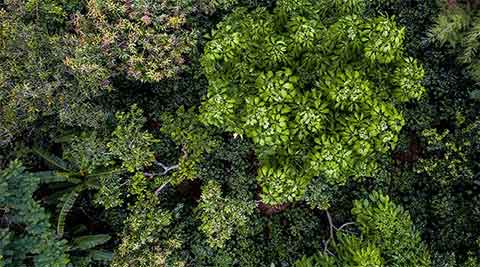Our packaging strategy

We are committed to helping to shape a waste-free future.
Our vision is that none of our packaging ends up in landfill or as litter. We are helping create a future where cleverly designed packaging, innovative new materials, better recycling infrastructure and reusable or refillable packaging can prevent waste on land and in oceans. This goal is ambitious, but we are determined to achieve it.
Participation from all levels of society is needed. As a member of the Ellen MacArthur Foundation’s New Plastics Economy initiative, we are committed to playing an active role in the development of well-functioning collection, sorting and recycling schemes across the countries where we operate. The global infrastructure gap is significant and not in immediate our control – but we are working to model successful collection and resource recovery systems with partners around the world.
We actively advocate for harmonized and better regulation of post-consumer resources and call on governments to accelerate progress on infrastructure development. We advocate for a legally binding UN Treaty on Plastic Pollution, which we hope will lead to new, harmonized national regulations.
How we are working to reduce our packaging
Our five-pillar packaging strategy
Our packaging strategy is science-based and benefits from the industry leading work of the Nestlé Institute of Packaging Science, which is the only research institute of its kind in the food industry. Set up in 2019, it has around 50 packaging experts dedicated to developing the next generation of sustainable packaging materials.
The Institute is helping to evolve the way packaging is designed. It is developing refillable or reusable packaging systems, designing simplified or recycled packaging materials and developing high-performance barrier papers and bio-based, compostable and biodegradable materials.
Our strategy is structured around five pillars:

Less packaging – Reduce
We want to use less packaging material, including less virgin plastic, which we plan to reduce by a third by 2025 versus our 2018 baseline.
Examples of how we are doing this include removing unnecessary plastic lids, accessories, layers and films, and in some countries, phasing out packaging items that are not widely recycled.
We launched several packaging innovations in Latin America: redesigning our Nescafé single-serve stick packs of coffee and Mahler Bouillon to reduce the plastic used in packaging by more than 200 tonnes combined.
In China, Nescafé light-weighted the ready-to-drink coffee bottles saving 1733 tonnes of plastics annually.

Less packaging – Reuse and refill
To eliminate the need for disposable packaging, we are working to eliminate non-recyclable plastics and investing in innovative, alternative delivery systems.
Many of these solutions are already in use in markets around the world, including refillable dispensers in Indonesia, which have been developed with technical partner Algramo and non-profit incubators Enviu. The new systems have been piloted for Milo and Koko Krunch in partnership with local retailers in Indonesia.
In Germany we have been running a pilot with start-up Circolution. Working in several grocery stores, the team tested new standardized reusable stainless-steel packaging for Nesquik, which can be integrated with existing return and cleaning infrastructure.
For transport packaging, innovations have helped us replace the plastic shrink-wrap on our pallets, while switching to reusable shipping boxes.
We recognize that more needs to be done and are working with different working groups along the value chain, such as Consumer Goods Forum and the Ellen MacArthur Foundation.

Better packaging – Redesign
We are collaborating with industrial partners to develop new packaging materials and solutions.
By the end of 2021, we had eliminated all plastic straws from our products, developing bespoke papers as an alternative material.
Across our portfolio, we are continually evaluating our materials and testing and introducing alternatives, such as recyclable paper for Maggi bouillon cubes in France, to replace multi-material wrappers.
We aim to design 100% of our plastic packaging for recycling and are phasing out non-recyclable materials. By the end of 2023, 83.5 % of our plastic packaging had been designed for recycling.

Better system – Recycle
We work to help stop plastic waste the environment across our global operations.
We support collection, sorting and recycling infrastructure in the countries where our products are sold and, in some countries, aim to collect and recycle the same amount of plastic as we use in our products under a “one tonne in, one tonne out” principle.
For example, in Malaysia, Nestlé joined forces with Petaling Jaya City to launch a door-to-door collection and recycling program as a voluntary recovery initiative. This pioneering program has been recognized by both the United Nations Environment Program (UNEP) and the Ministry of Environment Malaysia as an example of separation-at-source best practice.

Better system – Rethinking behaviors
Addressing the plastic waste challenge requires fundamental behavioral change from all of us, including Nestlé, retail partners, suppliers and consumers.
We have rolled out Packaging Sustainability training for our employees, and aim to educate and encourage others through a diverse range of programs and campaigns, helping everyone imagine a waste-free future. Examples include Nespresso’s capsule collection program videos, the Dove Lo Butto digital platform in Italy, which helps customers identify the nearest location to dispose of their packaging waste, and Nescafé Dolce Gusto consumer education campaigns in Germany and Mexico.
In the United States, Nestlé Health Sciences have eliminated hard-to-collect and recycle over-cap seals for vitamins and supplements. Our brands Pure Encapsulations and Atrium Innovations supported the innovation with a digital campaign.
In Brazil, France and Switzerland our coffee brands Nescafe Dolce Gusto and Nespresso launched compostable coffee pods. A digital campaign, together with on-pack information encouraging the separation of household organic waste and compostable materials, raised awareness among consumers.








